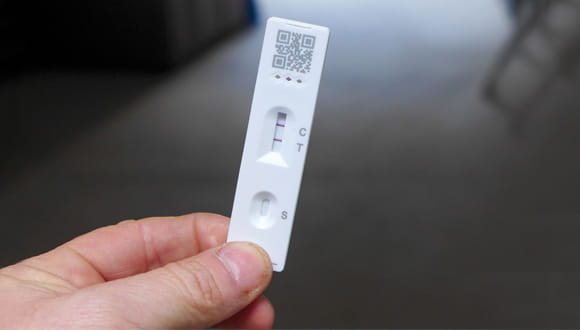What Should You Do After Testing Positive for COVID-19?
Jan. 5, 2022 - Katie McCallumYou've tested positive for COVID-19. Now what?
Whether you're unvaccinated, partially vaccinated or fully vaccinated (which includes the booster), here's what to do if you find out you have COVID-19:
1. Isolate
The CDC recommends isolation if you're infected with the virus — even if you don't have symptoms and even if you're vaccinated.
Keep in mind, isolation not only means not leaving the house, but also keeping your distance from uninfected people with whom you share your home.
Ideally, it's best to eat and sleep in your own space, away from others, as well as use your own bathroom.
If you do need to be in a shared living space:
- Wear a mask
- Avoid contact with others, including pets
- Do not share items, such as towels, blankets and cups
2. Alert those you came in close contact with
There may be a period of panic after testing positive — not just for your own health, but for the health of others you may have been around recently.
As soon as possible, identify anyone with whom you came in close contact while contagious and alert them that you've tested positive.
You're contagious with COVID-19 as early as:
- Two days prior to symptom onset or testing positive
If you have COVID-19, close contact is defined as:
- Being within 6 feet of someone for a combined total of 15 minutes or more over a 24-hour period while contagious
Bottom line: It's incredibly important to let people know that they have been exposed, so they can take the necessary quarantine precautions and get tested as recommended.
3. Alert your doctor
Most people experience only mild symptoms while ill with COVID-19, ranging from dry cough and fever to headache, fatigue and sore throat. (Related: How to Treat Mild COVID-19 Symptoms at Home)
Still, it's a good idea to let you doctor know you have COVID-19. He or she can help you understand if there are any next steps for your treatment, including being prescribed oral medications for COVID-19.
If you tested positive via an at-home rapid antigen test, your doctor can also help you determine how to report your positive result to the local health department. This is important since it helps provide public health officials an accurate picture of the virus' spread in the community.
If your COVID-19 test was performed at a hospital, urgent care center, pharmacy or testing site, it will get reported through official channels. But it's still a good idea to check in with your doctor, especially if your symptoms progress.
4. Monitor your symptoms
Some people are more likely to get severely sick from COVID-19 so it's important to monitor for worsening symptoms.
Seek emergency care if you experience any of the following:
5. Continue to isolate following the CDC's guidelines
First thing’s first, if you are a health care worker, refer to the CDC’s isolation guidelines for health care personnel and contact your employer with any questions.
Everyone else should follow the CDC's isolation guidelines for the general public, starting by isolating for at least five full days.
Keep in mind, your isolation timeline begins on Day 0, the day you either notice symptoms or test positive. Day 1, then, is the first full day after that.
The guidelines then vary based on whether you are:
- Asymptomatic (no symptoms)
- Experiencing mild symptoms
- Experiencing moderate symptoms (shortness of breath and difficulty breathing)
- Immunocompromised or experiencing severe symptoms (requiring hospitalization)
If you're still unsure how long you should isolate, use the CDC's isolation calculator for help and contact your doctor with any questions.
Lastly, for those who are able to end isolation after 5 days, you'll need to do more than just wear a well-fitted mask for 5 more days, including:
- Avoiding going places where you are unable to wear a mask, such as restaurants
- Continuing to isolate for a full 10 days if you're unable to wear a mask while around others
- Avoiding people who are immunocompromised or high risk for 5 more days
- Avoiding travel until 10 full days have passed since your first day of symptoms
Download a PDF of our Isolation Guidelines chart here >
6. Make a plan to get vaccinated or boosted once you've recovered
If you're unvaccinated, get vaccinated as soon as you've ended isolation.
Studies show that unvaccinated adults are twice as likely to get COVID-19 a second time than those who get vaccinated after recovering. (Related: How Soon Can You Get Vaccinated After Recovering From COVID-19?)
If you're vaccinated but haven't yet received a booster and you are eligible for one, make your plan to get one once you've recovered. (Related: How Do I Know If I Need a COVID-19 Booster Shot?)








